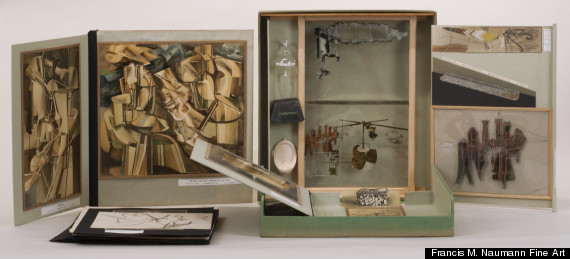Here is a gem of a show that, although small in scale, yields too many intellectual and aesthetic pleasures to be ignored. Duchamp champion and scholar Francis M. Naumann has orchestrated a family reunion of sorts where four out of the six Duchamp siblings partake as if in a rendezvous d'outre tombe. Three brothers -- Raymond, Jacques, and Marcel, and one sister, Suzanne -- light the lights while delighting in sophisticated puns and tender double entendres. As in a joyful family game, juxtapositions, ricochets, and allusions abound. Underneath the playful repartee, there is always the same mother who, according to the catalog, spent much of her free time drawing and painting, and whose own father, Emile-Frederick Nicolle (1830-1894), was a printmaker of considerable talent.

Marcel Duchamp
Boite-Alerte: Missives Lascives, 1959
Imitated rectified readmade: two Potholders (male and female)
The genealogy of art in the Duchamp family runs deep. This is precisely what makes this meticulously-focused exhibition so fascinating: It demonstrates how the Duchamp legacy was honed over at least three generations of artists. It also reveals how the best known and most gifted of the three Duchamp brothers, Marcel, forever disrupted the family legacy while assuring its perpetual afterlife. It is remarkable, for instance, to learn that Marcel Duchamp helped organize three family exhibitions, each undoubtedly with the purpose of "selling" the Duchamp name to an American and French public. In 1952, he organized a show for the Rose Fried Gallery in New York called Duchamp Frères et Soeur: Oeuvres d'Art (the name of the current show is a direct translation of that title). This first family exhibition was accompanied by a catalog designed by Duchamp in the format of a checkbook (for this show Francis M. Naumann wrote a new introduction but kept the ready-made format). In 1957, Duchamp helped James Johnson Sweeney organize an exhibition of the Duchamp brothers for the Guggenheim Museum in New York and, finally, in 1967, he helped reunite Les Duchamps for the Musée des Beaux Arts in Rouen, the family's hometown.
All this certainly points to an artist who wanted to portray his as a large, but tightly-knit family with a broad range of talents, all contributing to the success of a "family business." However, by showing his own work next to that of his two brothers and sister, Marcel was also articulating an independent place for himself. This creates an interesting paradox: It invites us to look at Marcel Duchamp within a clear family structure while always demonstrating his own clear differences from the work of his siblings.
Taken together, the works form an unusual family portrait. Through the prism of family and place, they enable the viewer to recognize in Marcel Duchamp the role of a rebellious middle child. Long before he shocked the art world, he was already predisposed to mischievous behavior that helped distance him from the artistic claims his two more established artist brothers might have made on him. As can be seen in many paintings on view, healthy sibling rivalry often took place around a game of chess, safely transferring brotherly battles to the symbolic realm of the chessboard or painted tableau. And it was of course during these early games of chess between Jacques and Raymond that the young Marcel developed his cerebral approach to art making, thereby forever changing the destiny of the Duchamp family, and with it, the fate of modern art in the twentieth century.

Marcel Duchamp
de ou par MARCEL DUCHAMP ou RROSE SELAVY, or the Boîte-en-valise, 1961
Series "D" box, containing miniature reproductions of Duchamp's work, 15 ¾ x 15 x 3 ½ inches
Duchamp Brothers & Sister: Works of Art
Francis M. Naumann Fine Art
24 West 57th Street, New York, N.Y. 10019
Gallery hours: Tuesday through Saturday 11:00 to 6:00
Sept. 28 to Nov. 23, 2012